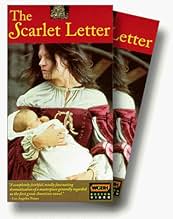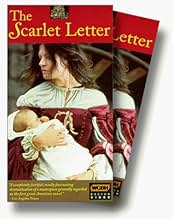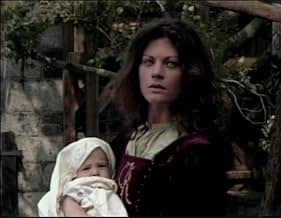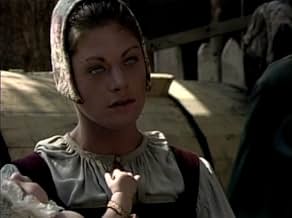अपनी भाषा में प्लॉट जोड़ेंIn 17th-century Massachusetts, a married woman whose husband has been absent for years with his whereabouts unknown has an affair that results in an out-of-wedlock daughter. The Puritan resi... सभी पढ़ेंIn 17th-century Massachusetts, a married woman whose husband has been absent for years with his whereabouts unknown has an affair that results in an out-of-wedlock daughter. The Puritan residents of her town condemn her carry the Scarlet Letter of Shame. Suddenly her husband reap... सभी पढ़ेंIn 17th-century Massachusetts, a married woman whose husband has been absent for years with his whereabouts unknown has an affair that results in an out-of-wedlock daughter. The Puritan residents of her town condemn her carry the Scarlet Letter of Shame. Suddenly her husband reappears.
- 1 प्राइमटाइम एमी जीते
- कुल 1 जीत
फ़ीचर्ड समीक्षाएं
When Pearl is a baby, she cries incessantly into a microphone that had to have been placed directly next to her. The poor camera quality makes Meg Foster's pale eyes seem psychotic or demonic. The special effects are so ridiculous that the audience can't help but chuckle. A scene between Hester and Chillingworth is nearly drowned out by the ocean nearby. The theme music never changes, and the narration is slow and monosyllabic. Add to that some pathetic acting performances, and there are some scenes that are just hard to sit through. If if weren't for the faithfulness to the text, and that fact that all other versions waver dramatically, this would be unwatchable.
On the negative side, the momentum sags in Part 3, the use of videotape over film (which the BBC did quite a lot of back then, too) fails to create the necessary atmosphere for a tale with underlying supernatural elements, and the child playing young Pearl is annoying--but so were most child performers of the period.
This are minor quibbles, however, and I still found the production thoroughly engrossing.
An early New England of around 1649 is portrayed. The high standards and harsh penalties imposed by the Puritan's Protestant church, is what allows for the events to unfold. These were people not far removed from our pilgrim founders. The story begins with a young woman named Hester Prynne, standing upon a scaffold holding her illegitimate baby. She was a married woman, whose husband had been presumed lost at sea, and thereby was known to have committed adultery in the getting of the child. She is pressed to reveal the man with whom she consorted and sinned. She will not. She is resolute. Because of this, her punishment is to wear a "scarlet letter 'A'" upon her bosom. She is gifted with the art of needlework, and embroiders an entirely beautiful and large letter 'A' on a dark red cloth. She wears this day and night, as she strives to raise her little girl, Pearl, in loneliness and poverty, using her skill with sewing as a means of support for them both.
We are soon, slowly and purposely, allowed to know who is the father of Hester's child, and partner in her sin. He is the honorable, and beloved of the people, Reverend Arthur Dimmesdale. But while Hester wears her "scarlet letter" openly over her heart, dealing with others scorn and social banishment, the Reverend Dimmesdale hides his same sin inside his heart, and suffers with his own knowledge, all the while the people seem to love him the more for his seeming humility, and self-deprecation.
To add salt to the wound for Hester, her husband, who had been found by "savages" and learned much in the arts of herbal medicines, made his way to the young Massechussetts settlement in time to see his wife upon the scaffold. He changes his name, forcing a promised silence from his former wife on the matter, and sets about to find and destroy the man with whom she sinned. Thus begins the slow, well thought out, and well executed plan of Roger Chillingworth. In the semblance of kindness as a doctor, he works upon Reverend Dimmesdale's secret shame, and guilty heart. For Dimmesdale, the shame is not just the sin of adultery. It is the fear of reproach from the people that leads him to choose to keep his part secret. To allow Hester to stand alone on the scaffold. To allow her to bear the chastisement of the entire community by wearing her "scarlet letter". And by putting her in the position of finding her own means to support their child.
It is after seven years of his suffering, obvious ill health, and a habit of holding his hand over his heart that the Reverend Dimmesdale is sought out by Hester Prynne, to reveal to him the evil that has been wrought upon him by his supposed friend, Roger Chillingworth. She does this in an attempt to release him from her husbands devilish clutches. To help him to look at the good he has done the community and to cease his slow and determined path to the grave. But in this long desired reunion between the two, Dimmesdale says to Hester, "Had I not loved God, even had I been an atheist, I would long since have found peace. Nay, I never would have lost it." They renew words of love and devotion to each other and look to leave the settlement, in hopes of finding a new life to live and be productive in, and to be together.
Hawthorne does not give us our "Hollywood ending", however. He chooses to bid us learn the value of an open admission to decisions and difficulties in life. To understand that the secrets that we carry in our hearts will show upon our outward appearance, whether we want it or no. He allows for God's goodness and mercy to the penitant, even though it may not be in this life that one attains it.
This version was produced at a time when PBS was primarily importing the serializations of books from British television. Therefore, it was made in that same style of the 1970's UK productions. The feeling while watching this video, is that of less production, and more of "right behind the camera". In recent years we have all become accustomed to the "movie" feel of the TV movies, or serialized books. Such as those produced by A&E or PBS, often in conjunction with BBC or another UK company (i.e."Pride and Prejudice", "Horatio Hornblower", etc.). Therefore, one must be prepared and not distracted by this type of production. In a way, I find them, interestingly, more intimate. I would say that this production is well worth the length of time spent watching a serialization (4 hrs). It is a deeply moving story, done with accuracy and quality, and wonderful acting. This viewer highly recommends it.
क्या आपको पता है
- ट्रिवियाThe filmmakers' decision to outfit Hester Prynne with a gold letter "A" was sharply criticized at the time of the mini-series' premiere on P.B.S. as author Nathaniel Hawthorne was quite specific about the "scarlet letter" being red-colored. In the novel, the adjective "scarlet" wasn't only used in the symbolic sense (scarlet meaning "grossly and glaringly offensive" in the sense of "sinning in flagrant and scarlet fashion" [deriving from the use of the word in Isaiah 1:18 & Revelation 17:1-6], thus being associated with sexual immorality); the letter sewn onto Hester Prynne's clothing in the novel actually was colored scarlet, albeit it was sewn to her clothing with gold thread. In the words of Hawthorne, "...[W]ith all the townspeople assembled and levelling their stern regards at Hester Prynne, - yes, at herself, - who stood on the scaffold of the pillory, an infant on her arm, and the letter A, in scarlet, fantastically embroidered with gold thread, upon her bosom!" (Chapter Two).
- कनेक्शनVersion of The Scarlet Letter (1908)
टॉप पसंद
- How many seasons does The Scarlet Letter have?Alexa द्वारा संचालित
विवरण
- रिलीज़ की तारीख़
- कंट्री ऑफ़ ओरिजिन
- आधिकारिक साइट
- भाषा
- इस रूप में भी जाना जाता है
- La letra escarlata
- फ़िल्माने की जगहें
- उत्पादन कंपनी
- IMDbPro पर और कंपनी क्रेडिट देखें
इस पेज में योगदान दें



























